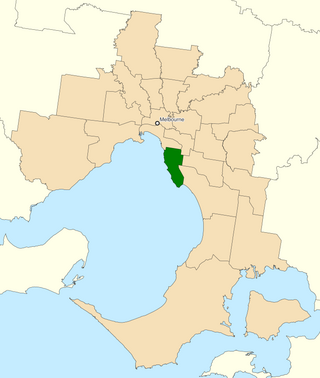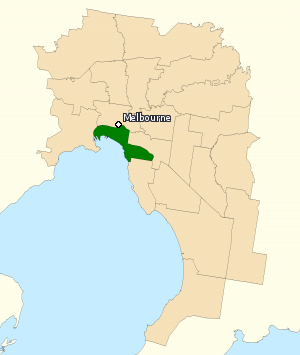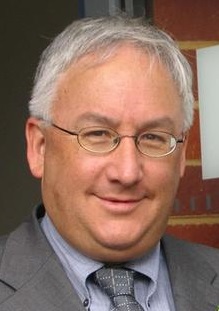
The Division of Higgins is an Australian Electoral Division in Victoria for the Australian House of Representatives. The division covers 41 km2 (16 sq mi) in Melbourne's inner south-eastern suburbs. The main suburbs include Armadale, Ashburton, Carnegie, Glen Iris, Kooyong, Malvern, Malvern East, Murrumbeena, Prahran and Toorak; along with parts of Camberwell, Ormond and South Yarra. Though historically a safe conservative seat, Higgins was won by the Liberal Party by a margin of just 3.9 percent over the Labor Party at the 2019 election, the closest result in the seat’s history. It then flipped to Labor in the 2022 election.

The Division of Adelaide is an Australian electoral division in South Australia and is named for the city of Adelaide, South Australia's capital.

The Division of Hindmarsh is an Australian Electoral Division in South Australia covering the western suburbs of Adelaide. The division was one of the seven established when the former Division of South Australia was split on 2 October 1903, and was first contested at the 1903 election, though on vastly different boundaries. The Division is named after Sir John Hindmarsh, who was Governor of South Australia from 1836 to 1838. The 78 km² seat extends from the coast in the west to South Road in the east, covering the suburbs of Ascot Park, Brooklyn Park, Edwardstown, Fulham, Glenelg, Grange, Henley Beach, Kidman Park, Kurralta Park, Morphettville, Plympton, Richmond, Semaphore Park, Torrensville, West Beach and West Lakes. The Adelaide International Airport is centrally located in the electorate, making noise pollution a prominent local issue, besides the aged care needs of the relatively elderly population − the seat has one of Australia's highest proportions of citizens over the age of 65. Progressive boundary redistributions over many decades transformed Hindmarsh from a safe Labor seat in to a marginal seat often won by the government of the day.

The Division of Brisbane is an Australian electoral division in the state of Queensland.

The Division of Melbourne is an Australian electoral division in the State of Victoria, represented since the 2010 election by Adam Bandt, leader of the Australian Greens.

The Division of Goldstein is an Australian Electoral Division in Victoria. The division was created in 1984, when the former Division of Balaclava was abolished. It is located in the bayside suburbs of Melbourne, including Beaumaris, Bentleigh, Brighton, Caulfield South, Cheltenham (part), Glen Huntly (part), Elsternwick, (part), Gardenvale and Sandringham.

The Division of Wills is an Australian electoral division of Victoria. It is currently represented by Peter Khalil of the Australian Labor Party.
The Division of Kooyong is an Australian Electoral Division for the Australian House of Representatives in the state of Victoria, which covers an area of approximately 59 km2 (23 sq mi) in the inner-east suburbs of Melbourne. It is currently based on Kew, and also includes Balwyn, Canterbury, Deepdene, Hawthorn, Mont Albert and Mont Albert North; and parts of Camberwell, Glen Iris, Hawthorn East and Surrey Hills.

The Division of McEwen is an Australian Electoral Division in the state of Victoria. Classed as a rural seat, the electorate is located in the centre of the state, north of its capital city Melbourne. It includes the outer northern suburbs of Doreen, Mernda, and Wollert, and extends along the Hume Freeway north of the metropolitan area to include the towns of Gisborne as well as Wallan as well as many other small towns.

The electoral district of Caulfield is an electoral district of the Victorian Legislative Assembly. The electorate is surrounded by the other electoral districts of Prahran, Albert Park, Malvern, Oakleigh, Bentleigh and Brighton.

The Division of Melbourne Ports was an Australian federal electoral division in the inner south-eastern suburbs of Melbourne, Victoria, Australia. It was located to the south of Melbourne's central business district and covered an area of approximately 40 km2 around the north and north-eastern shores of Port Phillip Bay.

Michael David Danby is an Australian politician who was an Australian Labor Party member of the Australian House of Representatives from 1998 until 2019, representing the Division of Melbourne Ports, Victoria. Danby was briefly Parliamentary Secretary for the Arts, from March to September 2013.

In Australian politics, the two-party-preferred vote is the result of an election or opinion poll after preferences have been distributed to the highest two candidates, who in some cases can be independents. For the purposes of TPP, the Liberal/National Coalition is usually considered a single party, with Labor being the other major party. Typically the TPP is expressed as the percentages of votes attracted by each of the two major parties, e.g. "Coalition 50%, Labor 50%", where the values include both primary votes and preferences. The TPP is an indicator of how much swing has been attained/is required to change the result, taking into consideration preferences, which may have a significant effect on the result.

The 2010 Australian federal election was held on Saturday, 21 August 2010 to elect members of the 43rd Parliament of Australia. The incumbent centre-left Australian Labor Party led by Prime Minister Julia Gillard won a second term against the opposition centre-right Liberal Party of Australia led by Opposition Leader Tony Abbott and Coalition partner the National Party of Australia, led by Warren Truss, after Labor formed a minority government with the support of three independent MPs and one Australian Greens MP.

The 2014 Victorian state election, held on Saturday, 29 November 2014, was for the 58th Parliament of Victoria. All 88 seats in the Victorian Legislative Assembly and 40 seats in the Victorian Legislative Council were up for election. The incumbent centre-right Coalition minority government, led by Liberal Party leader and Premier Denis Napthine and National Party leader and Deputy Premier Peter Ryan, was defeated by the centre-left Labor Party opposition, led by Daniel Andrews. The Greens won two lower house seats, their first Legislative Assembly seats in a Victorian state election, whilst increasing their share of upper house seats. The new Andrews Ministry was sworn in on 4 December 2014.

The 2019 Australian federal election was held on Saturday 18 May 2019 to elect members of the 46th Parliament of Australia. The election had been called following the dissolution of the 45th Parliament as elected at the 2016 double dissolution federal election. All 151 seats in the House of Representatives and 40 of the 76 seats in the Senate were up for election.

The Division of Monash is an Australian Electoral Division in the state of Victoria, which was contested for the first time at the 2019 federal election.

The Division of Cooper is an Australian Electoral Division in the state of Victoria. It takes in the northern suburbs of Melbourne. The division was contested for the first time at the 2019 federal election, with Ged Kearney of the Australian Labor Party (ALP) elected as its inaugural member of parliament. She had previously represented the Division of Batman since the 2018 by-election.

Joshua Solomon Burns is an Australian politician. Representing the Australian Labor Party, he was elected as the member for the division of Macnamara in Melbourne at the 2019 Australian federal election.

Steph Hodgins-May is a Greenpeace activist who has been a candidate for the Australian Greens in multiple federal elections.




















